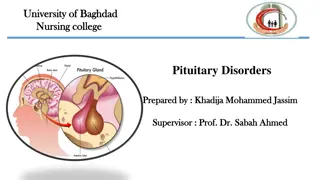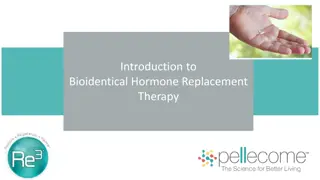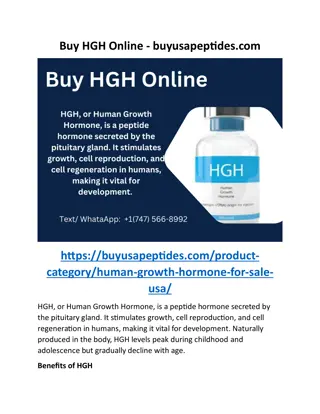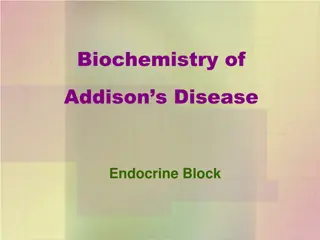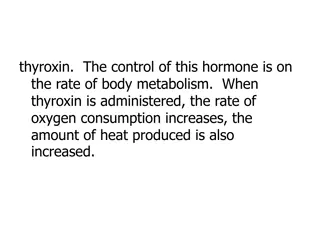Insights into Human Growth Hormone and Its Medical Applications
Human Growth Hormone (HGH), a key hormone secreted by the anterior pituitary gland, plays a crucial role in stimulating growth and metabolism. Its therapeutic applications range from treating growth hormone deficiency in children to genetic engineering for pharmaceutical production. HGH has made significant contributions to medical advancements, especially in tackling hormonal imbalances and promoting growth in both children and adults.
Download Presentation

Please find below an Image/Link to download the presentation.
The content on the website is provided AS IS for your information and personal use only. It may not be sold, licensed, or shared on other websites without obtaining consent from the author. Download presentation by click this link. If you encounter any issues during the download, it is possible that the publisher has removed the file from their server.
E N D
Presentation Transcript
Growth hormone (somatotropin) size 191 amino acids mol wt. 22125 kd is secreted by Anterior Pituitary Growth hormone stimulates production of insulin-like growth factor 1. Insulin-like growth factor 1 is an essential component of the promotion of growth in children, and in adults It controls metabolism
Infants and children who lack sufficient endogenous levels of human growth hormone Patients with chronic renal insufficiency (defective kidneys), Turner syndrome Respond to treatment with growth hormone It stimulates Tissue and bone growth, increases protein synthesis Mineral retention Decreases body fat storage
In pharmaceuticals produced by recombinant DNA technologies for commercial use. 1982, human insulin became the first Since then, several other human proteins with medicinal value have been synthesized in bacteria. Some of the first human proteins to be produced in microorganisms were : Blood-clotting factor VIII (lacking in individuals with one type of hemophilia) Plasminogen activator (a protein that disperses blood clots) Human growth hormone (a protein deficient in certain types of dwarfism).
In 1985, hGH became the second genetically engineered pharmaceutical approved for use in humans by the U.S. Food and Drug Administration. The first recombinant growth hormone was called somatrem (Protropin) It had an amino acid sequence that was identical to that of human growth hormone, except that there was an extra methionine residue at the N-terminal end of the peptide chain
Only growth hormones from humans or from closely related primates will function in humans. Thus, prior to 1985, the major source of growth hormone suitable for treatment of humans was from human cadavers hGH, which is required for normal growth, is a single polypeptide chain 191 amino acids in length
To obtain expression in E. coli, the hGH coding sequence must be placed under the control of E. coli regulatory elements. Therefore, the hGH coding sequence was joined to the promoter and ribosome-binding sequences of the E. coli lac operon
To accomplish this, a HaeIII cleavage site in the nucleotide-pair triplet specifying codon 24 of hGH was used to fuse a synthetic DNA sequence encoding amino acids 1 23 to a partial cDNA sequence encoding amino acids 24 191. This unit was then inserted into a plasmid carrying the lac regulatory signals and introduced into E. coli by transformation
The hGH produced in E. coli in these first experiments contained methionine at the amino terminus (the methionine specified by the ATG initiator codon). Native hGH has an amino-terminal phenylalanine: a methionine is initially present but is then enzymatically removed. E. coli also removes many amino-terminal methionine residues posttranslationally. However, the excision of the terminal methionine is sequence-dependent, and E. coli cells do not excise the amino-terminal methionine residue from hGH. Nevertheless, the hGH synthesized in E. coli was found to be fully active in humans despite the presence of the extra amino acid.
More recently, a DNA sequence encoding a signal peptide (the amino acid sequence required for transport of proteins across membranes) has been added to an hGH gene construct. With the signal sequence added, hGH is both secreted and correctly processed The methionine residue is removed with the rest of the signal peptide during the transport of the primary translation product across the membrane. This product is identical to native hGH.
in 2004, the U.S. Food and Drug Administration (FDA) approved the use of recombinant human growth hormone for individuals whose short stature was caused by a variety of medical conditions other than human growth hormone deficiency.
Native human growth hormone binds to both growth hormone and prolactin receptors that occur on a number of different cell types. To avoid unwanted side effects during therapy, it is desirable that human growth hormone bind only to growth hormone receptors. Site-specific mutagenesis of the cloned human growth hormone cDNA was used to change some of the amino acid side chains that act as ligands for Zn2+ (i.e., His-18, His-21, and Glu-174), because the ion is required for the high-affinity binding of human growth hormone to the prolactin Receptor These modifications derivatives that bound to the growth hormone receptor but not to the prolactin receptor. yielded human growth hormone
Short half-life in plasma, human growth hormone therapy currently requires subcutaneous injection once a day. This treatment is both inconvenient and expensive. The extracellular domain of the human growth hormone receptor was fused to human growth hormone This construct has a very strong tendency to dimerize as the growth hormone moiety from one molecule binds with the receptor portion of another molecule. When this growth hormone construct was tested in rats, a single injection promoted growth for 10 days
Another method that has been devised to prolong the active lifetime of human growth hormone includes fusing the coding sequences for the C-terminal end of human growth hormone with the N-terminal end of human serum albumin. This fusion protein is called Albutropin The stabilization of the human growth hormone portion of Albutropin reflects the stability of human serum albumin, which has a half-life in serum of about 19 days.



